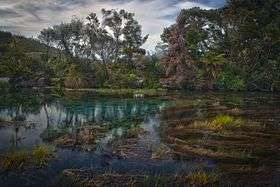Te Waikoropupū Springs

The Te Waikoropupu Springs ('Pupu Springs') are located in Golden Bay, on New Zealand's South Island. The springs are known for the clarity of the water, and the volume of water discharged. The springs are spiritually significant to the Māori people.
Water clarity
The horizontal visibility of the constantly 11.7 °C cool water in the springs has been measured at an average of 63 metres, and until 2011 was considered second only to sub-glacial water in the Antarctic.[1] Since that year, however, the record holder for fresh water clarity is the Blue Lake (Tasman) still in New Zealand.[2][3]
Volume of water

The springs are notable for the volume of water discharged from the eight main vents. It is estimated that 14,000 litres of water are produced per second, approximately enough to fill 40 bathtubs. In a 1974 television documentary, it was noted that this would be enough water to supply a city the size of Boston, Massachusetts. The floor of the lake is covered with white sand. Waters expelled from some of the smaller vents carry the sand upward. These vents are known as the 'dancing sands', which for the few scuba divers who have secured permission to dive in the springs, is one of the highlights of underwater sightseeing.
Spiritual significance

The Springs have been registered as Wahi Tapu with the Māori Heritage Council of the New Zealand Historic Places Trust. Waikoropupu is the legendary home of the female taniwha, Huriawa, one of the three main taniwha of Aotearoa. She is a diver of land and sea, travelling deep beneath the earth to clear blocked waterways. She is brave and wise and believed to still rest in the waters of Waikoropupu, when she is not away attending to business.
At the entrance to the walkway to the springs, the Department of Conservation has placed a sign:
"Te Waikoropupu Springs are a taonga (treasure) and waahi tapu (a sacred place) for Māori, both locally and nationally. The legends of Te Waikoropupu are told in the stories of Huriawa, its taniwha (guardian spirit). In Māori tradition the Springs are waiora, the purest form of water which is the wairua (spiritual) and the physical source of life. The Springs provide water for healing, and in the past were a place of ceremonial blessings at times of birth and death and the leaving and returning of travellers."
Coordinates: 40°50′52″S 172°46′10″E / 40.8477°S 172.7694°E
References
| Wikimedia Commons has media related to Te Waikoropupū Springs. |
- ↑ "Te Waikoropupū Springs: Golden Bay Places to visit". doc.govt.nz. 2012. Retrieved 10 April 2012.
In 1993, The National Institute for Water and Atmosphere (NIWA) carried out optical measurements under water and found that the visibility was 63 metres.
- ↑ "Nelson's Blue Lake – The clearest freshwater ever reported". NIWA. Retrieved 20 December 2011.
- ↑ "Nelson's Blue Lake clearest". New Zealand Herald. 20 December 2011. Retrieved 20 December 2011.